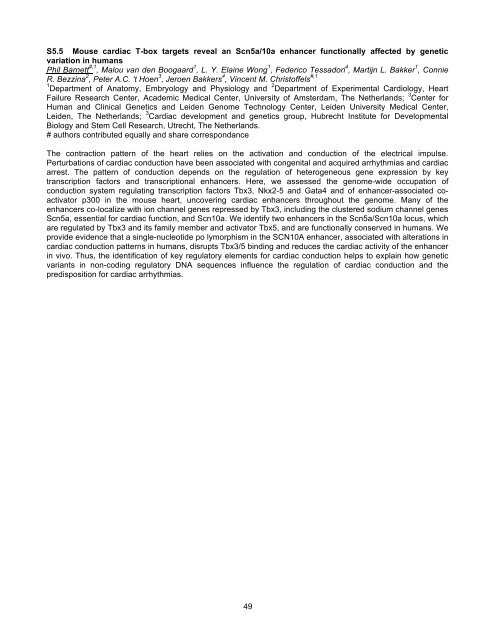Abstract Book Cover - Weinstein 2012 - University of Chicago
Abstract Book Cover - Weinstein 2012 - University of Chicago
Abstract Book Cover - Weinstein 2012 - University of Chicago
Create successful ePaper yourself
Turn your PDF publications into a flip-book with our unique Google optimized e-Paper software.
S5.5 Mouse cardiac T-box targets reveal an Scn5a/10a enhancer functionally affected by genetic<br />
variation in humans<br />
Phil Barnett #,1 , Malou van den Boogaard 1 , L. Y. Elaine Wong 1 , Federico Tessadori 4 , Martijn L. Bakker 1 , Connie<br />
R. Bezzina 2 , Peter A.C. ‘t Hoen 3 , Jeroen Bakkers 4 , Vincent M. Christ<strong>of</strong>fels #,1<br />
1 Department <strong>of</strong> Anatomy, Embryology and Physiology and 2 Department <strong>of</strong> Experimental Cardiology, Heart<br />
Failure Research Center, Academic Medical Center, <strong>University</strong> <strong>of</strong> Amsterdam, The Netherlands; 3 Center for<br />
Human and Clinical Genetics and Leiden Genome Technology Center, Leiden <strong>University</strong> Medical Center,<br />
Leiden, The Netherlands; 3 Cardiac development and genetics group, Hubrecht Institute for Developmental<br />
Biology and Stem Cell Research, Utrecht, The Netherlands.<br />
# authors contributed equally and share correspondance<br />
The contraction pattern <strong>of</strong> the heart relies on the activation and conduction <strong>of</strong> the electrical impulse.<br />
Perturbations <strong>of</strong> cardiac conduction have been associated with congenital and acquired arrhythmias and cardiac<br />
arrest. The pattern <strong>of</strong> conduction depends on the regulation <strong>of</strong> heterogeneous gene expression by key<br />
transcription factors and transcriptional enhancers. Here, we assessed the genome-wide occupation <strong>of</strong><br />
conduction system regulating transcription factors Tbx3, Nkx2-5 and Gata4 and <strong>of</strong> enhancer-associated coactivator<br />
p300 in the mouse heart, uncovering cardiac enhancers throughout the genome. Many <strong>of</strong> the<br />
enhancers co-localize with ion channel genes repressed by Tbx3, including the clustered sodium channel genes<br />
Scn5a, essential for cardiac function, and Scn10a. We identify two enhancers in the Scn5a/Scn10a locus, which<br />
are regulated by Tbx3 and its family member and activator Tbx5, and are functionally conserved in humans. We<br />
provide evidence that a single-nucleotide po lymorphism in the SCN10A enhancer, associated with alterations in<br />
cardiac conduction patterns in humans, disrupts Tbx3/5 binding and reduces the cardiac activity <strong>of</strong> the enhancer<br />
in vivo. Thus, the identification <strong>of</strong> key regulatory elements for cardiac conduction helps to explain how genetic<br />
variants in non-coding regulatory DNA sequences influence the regulation <strong>of</strong> cardiac conduction and the<br />
predisposition for cardiac arrhythmias.<br />
49


